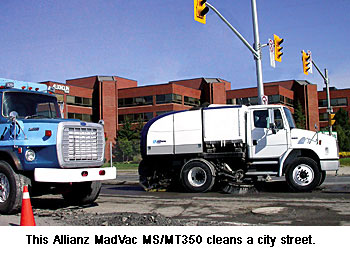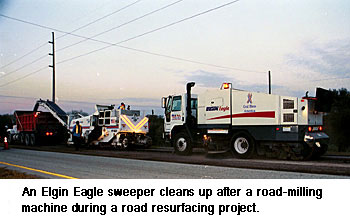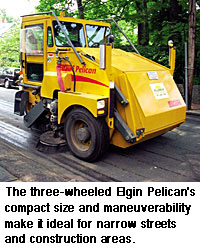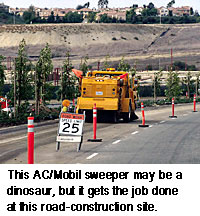Construction Sweeping: Safely and Efficiently |

From the Highway Contractor section of the August 2007 issue of 'Better Roads Magazine'by Ranger Kidwell-Ross, editor of WorldSweeper.com In this reprint of an article he did for Better Roads magazine, WorldSweeper.com's editor discusses the many factors to consider when hiring a construction sweeping contractor. 
In many parts of the country, environmental considerations have in recent years become the top reason for sweeping construction sites. The United States Environmental Protection Agency cites dirt track-out by vehicles from construction sites as one of the leading causes of pollution. This is considered a serious problem because track-out transports sediment and/or polluted material to places where it can easily be washed into water bodies, violating the Clean Water Act. Typically, sweeping is the best way to achieve the results required under the Act.
Equipment neededEPA rules don't specify any particular techniques or machinery. Rather, the EPA's regulatory requirements dictate only that comprehensive pollution-prevention plans are in place for construction projects. Whatever structural and housekeeping efforts the plans call for must be implemented to have a positive impact. Many individual states now have far more strict construction site regulations than those on the national level. The number of companies that offer quick-response and heavy-duty sweeping for the construction industry is relatively small. If you specify sweeping services for construction cleanup, make sure you hire a contractor that has construction sweeping experience, as well as the type of heavy-duty sweepers needed.
In most cases, these will be mechanical broom machines. That's because the transverse-broom action is needed to remove packed-down dirt and debris created on a construction site. In lighter debris situations, an air sweeper may be able to handle the job. If so, you can expect to pick up a larger proportion of the fine material, where a much higher portion of the total pollutants is contained. Good contractors neededIn construction sweeping, any missed areas will be noticed. Use a seasoned sweeper operator on any construction work -- someone capable of achieving superb results under the most demanding conditions. Especially with road milling, the sweeper's job changes hour-to-hour, and each jobsite location can pose a wide variety of new challenges. Karl Stauty is president of Virginia-based Commercial Power Sweeping. His company was the first in Virginia to become a Certified Contractor through the North American Power Sweeping Association. The firm has been construction sweeping for about 15 years. "Until recently, sweeping services required a hard sell to residential developments," Stauty says. "Now, these companies have become extremely concerned about complying with Phase II of the Clean Water Act because they know the statutes are being stringently enforced and don't want to be shut down, since that can be very expensive. 
"In Virginia Beach, for example, a contractor developed a site and then sold individual lots to a number of builders who thought it wasn't their responsibility to keep the access roads cleaned. The city's response was to just quit doing inspections, which got everyone's attention. Almost overnight the individual contractors got together and started a fund that paid for the level of sweeping needed. "Because we're near Chesapeake Bay, runoff pollution eventually makes it into the water. The closer any project is to the water, the more stringent the inspectors become, even if there are retention ponds or other remediation. And, we're not just sweeping ingress/egress roads now. An increased emphasis is being placed on keeping the internal areas of construction sites swept, too. "Most sweeping is still done with mechanical broom machines, and typical frequency is high enough that they do a good job. Although air-based sweepers are better for handling the small-micron material that creates dust, they can't handle packed-down mud and many of the larger items that are a natural byproduct of construction waste. When there's been a long dry spell, though, air sweepers are sometimes a better choice, since trying to sweep the dried-out material with a mechanical broom sweeper creates an increased level of dust. "One of the changes we've seen in Virginia is contractors building small, lined detention ponds to contain vehicle wash-off debris, especially from concrete trucks. At the end of the project, the pond is emptied of polluted debris before being filled. That makes our job easier, since trucks used to be washed off all over a jobsite. There's also a $500 fine for crossing a silt fence at an unapproved spot, so the debris now tends to be more centralized." Customer awarenessDavid Ross is president of Millennium Maintenance and Power Sweeping in Medford, Massachusetts. Ross says, "We're finding that even smaller towns are more aware of stormwater runoff pollution. On construction projects, where a few years ago they wouldn't even consider sweeping access roads, now they're mandating frequent sweeping. "Some people are familiar with mechanical brooms; most only know that they need a sweeper. No one seems educated yet about the difference between a mechanical broom sweeper, in contrast with a regenerative air or vacuum sweeper, both of which use suction for debris removal. Yet, if we're talking about true environmental sweeping, the reality on some sites is that only the initial heavier cleanup should be done with a broom sweeper. After that, especially if maintenance sweeping is specified on a daily basis, a regenerative air or vacuum sweeper is a better environmental choice. "For some sweeping jobs, especially roadway milling, we're seeing more requests for sweepers that can travel at highway speeds. A chassis-mounted sweeper is better for doing one section of highway, then running up several exits to do another. Time is saved when the sweeper doesn't have to be loaded and off-loaded on a trailer. Today's chassis-mounted broom sweepers can handle the heavier debris that used to require a three-wheel model. 
"Another change seems to be a direct result of the NPDES permits. It is a move toward tandem sweeping during our heavy spring cleanup. By following the broom sweeper with an air machine, the roads are being cleaned of both the heavy material and the fines -- where most of the pollutants are -- that a mechanical broom sweeper tends to leave behind." In Southern California, where many national environmental regulations originate, there is an enormous effort to remove material as small as PM-10 before it can become ambient dust. (By contrast, a human hair is about seven times as wide.) These small particles have been targeted because, when airborne, they are a major contributor to respiratory ailments. Many Southern California haul permits require that a sweeper be onsite -- at a typical cost of between $100 and $150 an hour -- whether there's one truck or 100 trucks at work. On some sites, there may be only a few shovelfuls of material in the containment hopper at the end of the day. A sweeper's viewMark Carter is principal in Orange County, California-based Bill's Sweeping and is a past president of NAPSA. The company was the first California sweeping firm to become a Certified Sweeping Contractor through that organization. "There's no question regulations have increased the use of sweepers, sometimes to a ridiculous level," says Carter. "The sweeping company used to be on the same team as the construction contractor. We were called in when, in the site manager's opinion, sweeping was needed. Now, when we're on a job because the statute requires it, our expensive, full-time presence is often seen as a negative. 
"We used to be a middleman on the job; we would sweep but weren't responsible for the final outcome. That's because, historically, the steps performed in construction cleanup were to use a skip loader, if needed for the large material, followed by a broom sweeper, and then a water truck to hose everything down. "With stormwater regulations, the water truck has been eliminated. This creates challenges for getting asphalt and slurry to adhere, because a broom can only get the roadway so clean. We're expected to get the pavement as clean as the flusher truck did, which we simply can't do with existing broom sweeper technology. "To address this problem, some customers request that we sweep dry [without using water for dust suppression]. Unless the model is designed to sweep without using water for dust suppression, as a few are, don't expect a contractor to be willing to sweep dry. You'll have a huge increase in dust. You're asking him to disable an important safety item that also has implications for increasing wear on his machine. "Another byproduct of increased stormwater education is that some inspectors specify whether a mechanical broom or an air sweeper must be used on particular jobs. Because they actually don't have in-depth knowledge about what both technologies can and can't do, they oftentimes require the wrong machine. "The key thing to look for is contractors that keep their sweepers well maintained and have trained, experienced operators who know what they're doing. Make sure you find someone who over delivers, not over promises. If the sweeper doesn't show up or is broken, it can sometimes stop the entire project. "Schedule your job as far in advance as possible. Let the sweeping company know of any changes, and expect to be charged if the sweeper shows up because you forgot to tell them your schedule changed. Schedule enough time for the sweeper to do its job. Don't schedule the sweeper at 7 a.m. and the oil truck for 7:30 a.m. This only frustrates everyone and runs the bill up needlessly. Keep the cost of sweeping in perspective with the rest of the job. I'm amazed at supervisors who will choose an inexperienced sweeping contractor that has poor equipment just to save $5 an hour on a $20-million job. They may lose many times their projected savings on downtime and inefficient operation." Carter also says it usually makes sense for a contractor to hire a sweeping firm rather than purchase a sweeper for low-to-moderate usage. Sweepers are pretty specialized. A backhoe, a roller, and a skip loader are all similar to repair, and operators can usually be interchanged. Sweepers are unique to maintain and repair, and operators need hundreds of hours at the controls before they are competent enough that you'd want them on a construction project of any size. When you consider a sweeping contractor, make sure the person you talk with asks the standard questions. They should want to know where they can get water [for dust suppression] legally, and they should ask about your debris disposal arrangements. Sweeping contractors typically want their machines to show up empty and leave empty. Perhaps the most important thing to find out is what the local government inspector wants to see as a finished product. This may range from no requirements to something as stringent as no visible dirt trail emerging from a jobsite. Having this information will determine the type and frequency of sweeper(s) needed. Increasingly stringent environmental laws and associated penalties have made compliance a no-nonsense issue. Especially when state or federal money is used, the penalties for noncompliance with runoff regulations can be significant. Construction Sweeping Considerations
• Proper safety equipment on a sweeper is paramount. Flashing lights, flags, and slow-moving-vehicle triangles are necessary. Make sure any sweeper on your jobsite has the safety equipment needed for any situation and/or that is required by statute in that location. Also provide them with the proper construction signage to let people know they are entering a construction zone and construction equipment is operating in the area. This can help slow traffic down, and really helps your legal defense if someone blows through the cones and hits a construction vehicle (or worker) on your site. • Consider getting a sweeper onto your construction site before an agency inspector requires it. The service will be less expensive due to prior planning, and it will be good public relations for your project to nearby neighbors. • In most parts of the country, taking water from a hydrant without permission or a meter is stealing. Don't expect a reputable sweeping contractor to do so. Make the necessary arrangements with the local jurisdiction for where the sweeper can get metered water. • Prior to getting bids for services, supply sweeping contractors with any needed information about issues surrounding the job. These include prevailing wage requirements, insurance needed, whether a contractor's license is required, any state or county regulations concerning air quality, and so on. • Be sure you are aware of all licenses needed for sweeping, as well as air quality jurisdiction requirements, and so on. Regulations are, these days, in a constant state of change. It's important to stay on top of whatever is the latest. • When you evaluate a sweeping contractor, make sure they have an office staff that answers the phone and that you can reach someone knowledgeable when you need them. Confirm that they have a replacement sweeper just in case the one on your job breaks down. Is their equipment in good shape? Are their drivers trained? When you look at their drivers, consider whether or not they are someone you'd have on your own crew.
For a PDF copy of this article as it appeared in Better Roads, which is suitable for a handout, click here. Ranger Kidwell-Ross can be reached easily via e-mail. |
© 2005 - 2021 World Sweeper
|
Construction Contents
|